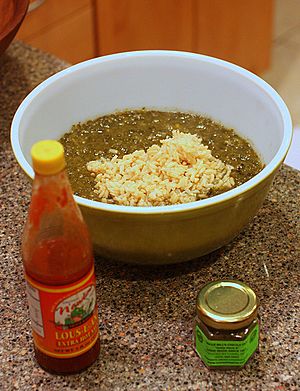Filé powder facts for kids
Filé powder, also called gumbo filé, is a special spice. It's made from the dried and crushed leaves of the sassafras tree. This tree grows in North America. Filé powder adds a unique taste to food.
Contents
What is Filé Powder?
Filé powder comes from the leaves of the sassafras tree. These leaves are picked when they are young. Then, they are dried and ground into a fine powder. This powder is used as a seasoning and a way to make dishes thicker.
How Filé Powder is Used in Cooking
Filé powder is very important in Louisiana Creole cuisine. It is a key ingredient in some types of gumbo. Gumbo is a thick soup or stew. It is often served over rice.
There are many kinds of gumbo. In New Orleans, gumbo recipes can be different in each home. But they all keep their Native American roots. Some types of gumbo use okra or a roux (a mix of fat and flour) to make them thick. Filé powder can also be used to thicken gumbo. It is especially helpful when okra is not available.
You should add filé powder at the end of cooking. Sprinkle it over the gumbo after the vegetables, meats, or seafood are done. Make sure to remove the pot from the heat first. This way, the filé powder gives a special earthy flavor and texture.
The Story Behind Filé Powder
The Choctaw people were the first to use dried sassafras leaves. They are Native Americans from the American South. They used these leaves as a seasoning in their food.
The word filé comes from a French word. It means "to turn into threads" or "to become ropy." This might describe how the powder thickens food.
The name gumbo might come from an African word. In some Bantu languages, ki ngombo or gombo meant okra. Okra was often used to thicken soups and stews. Many African people were brought to Louisiana a long time ago. They used okra in their cooking.
Some people think gumbo recipes came from West African soups. These soups were often thickened with okra. Over time, sassafras leaves (filé) became another way to thicken gumbo.
The first time gumbo was mentioned was in 1764. A woman named Comba said she gave "un gombeau" to another person.
Other experts think the name gumbo might come from the Choctaw word for filé, which was kombo. Long ago, gumbo with filé powder might have been a special dish for Native American tribes. In the late 1700s, rice was a luxury for many people. So, they often ate gumbo over corn grits. This was a common way to eat stews among native tribes.
Is Filé Powder Safe?
You might have heard about a substance called safrole. It is found in sassafras oil. For safety reasons, safrole and sassafras oil are not allowed in food products.
However, the good news is that filé powder is safe to eat. Studies have shown that the sassafras leaves used to make filé powder do not have harmful amounts of safrole. So, you can enjoy your gumbo with filé powder!
See also
 In Spanish: Gumbo filé para niños
In Spanish: Gumbo filé para niños


